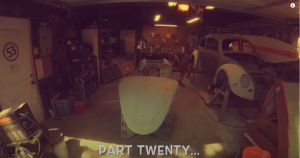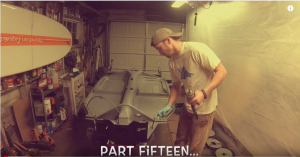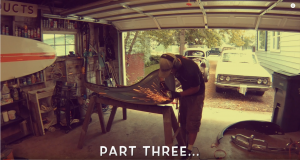Tools Needed:
No special tools needed for this step. Just some penetrating lube, a decent set of socket and open end wrenches, a couple screwdrivers, and possibly a breaker bar and hacksaw. Also, I like to keep some plastic baggies handy to save all the old nuts/bolts – I plan on using new hardware when I put it back together, but I never throw any old parts out until the very end.
If you’re tackling this job yourself, get a few cans of PB Blaster or Liquid Wrench (or any good quality penetrating lube) the night before you begin disassembling your bug. Go around and spray every bolt and screw you can get to. Under the fenders, running boards, the bumper bolts, the door/hood/deck lid bolts. Spray some in the screws that hold the headlights/taillights/turn signals and let it sit overnight. Then before you begin taking parts off, do it again! Most likely you’ll be dealing with years of rust and corrosion and this step will save you from snapping or stripping bolts which will cause a headache later on. I prefer PB Blaster.
Disassembling the bug
After letting it sit with the penetrating lube over night, I began work.
Removing the headlights:
I started with removing the headlights. Removing the headlights is straight forward – just unscrewing the screws that hold the headlight to the fender and detaching the wiring — later models will have a beauty ring that needs to be removed first, but it’s just a matter of unscrewing and taking the headlight out, then detaching/snipping the wires and feeding them out clear of the fender. I knew I’d be replacing the wiring harness, so I cut the wiring without much care.
If you plan to re-use the wiring harness, you should carefully remove the wires from the headlight connection block, or cut them at a place to leave yourself enough room to splice them back together because they won’t fit through the tube where the wiring runs through the fender to the trunk area.
Removing the hood and front bumper:
Once the lights were removed, I then removed the hood. The hood usually comes off easily since the bolts are under cover and less likely to be too badly corroded. Removing the hood gives easier access to the front bumper bolts which come next. Luckily, the hood and front bumper bolts came out without much trouble thanks to letting them sit overnight.
Even when being careful, you’re more than likely going to snap one or two of the bumper mounting bolts. It happens, and we’ll take care of it later, but if possible, get these bolts out cleanly. Start slowly and get them to move. Screw them in and out a few times (spraying PB as you go) until they move freely, then ease them out if they feel like they’re not coming out without creaking and binding. When they make a creaking noise, that’s usually when they’ll snap – and sometimes you can’t prevent it. Just go slow.
Removing front fenders:
After removing the front bumper, I removed the front fenders. The bumpers go through the fenders (in most years) so you can’t remove the fender without removing the bumper first. I put my bug up on jack stands to make life easier. Place the jack stands under the front torsion bar housing so it’s nice and balanced, then remove the front wheels so you can access the fender bolts.
If you have an old year like the 56, the wires run from the trunk to the fender in a metal tube that’s part of the fender, so just pull all the headlight/turn signal wiring out through the trunk and let them dangle there for now. Later models, you can just pull the wiring out the underside of the fender and let them hang there.
The front fenders were removed easily, except for the bolt that holds the fender to the running board. I had to cut that bolt to free the fender from the running board – no big deal since it’s just a bolt/nut/washer that I can easily replace when I put it back together.
The fender bolts are the same deal as the bumpers. Be very careful if they feel like they’re binding because you could rip the inserts right out of the body (which happened on my 67). This will happen especially if the body is rusted where the fenders meet the body. You might not snap the bolt, but now you have even more of a hassle when you get to the body work. There’s also a bolt that attaches the fenders to the running boards, and sometimes these are a pain. Get two wrenches on them and remove them if you can. If you can’t, just get a hacksaw and cut them in half since they’re easy to replace later. Just go slowly and use lots of PB.
Removing running boards:
After the front fenders were removed, I moved to the back fenders and removed the bolt that attaches to the running boards (cut them if you need to). And now it was time to remove the running boards. The running boards came off with no trouble thankfully. In my case, the rubber and chrome on the running boards was in rough shape, so after removing them from the car, I stripped them down to the metal and will be replacing the rubber/chrome later, but this step isn’t necessary.
The running boards attach to the heater channels, and if you’re heater channels are rotted out, then you’ll see that most of these bolts will just rip out instead of screw out. If this happens and you weren’t planning to replace the heater channels, then this just changed your mind. The heater channels should be replaced. If they come out without tearing the heater channel then that’s good news.
Rinse and repeat:
Next I moved to the back bumper and fenders. The process is the same. Jack up the bug and place jack stands under the rear torsion housing (or if you have a later model with IRS suspension, in an appropriate stable place), remove the wheels and repeat the process. The bumper first, then taillights, then fenders and deck lid. I ended up snapping one of the rear bumper bolts, so I’ll have to deal with that later. Finally, I removed the fuel tank to give easier access to body mounting bolts which I’ll get to in a later video.



